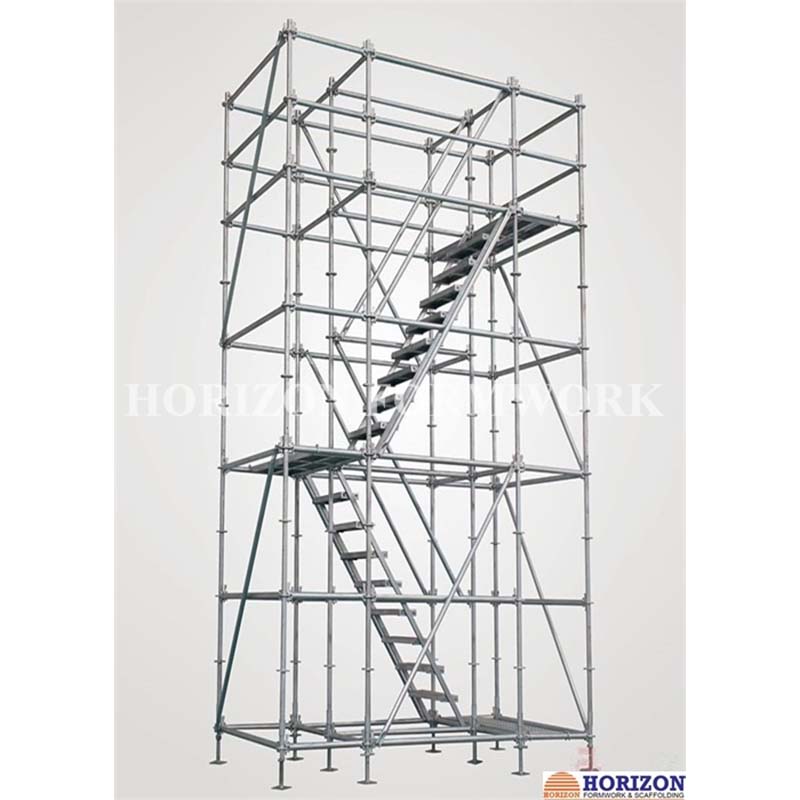ఏప్రి . 29, 2024 16:54 Back to list
Scaffold safety in construction Scaffolding
Scaffolds provide a safe and efficient way to work in construction. However, according to the Bureau of Labor Statistics, unsafe scaffolding caused 3,400 injuries and 56 work-related deaths in the U.S. in 2020. Scaffold hazards have ranked in the top five most common OSHA violations since 2016.
Ringlock Scaffolding System
Workplace safety requires employers and employees to recognize scaffolding hazards and make sure every scaffold is used properly. Although there are many different types of scaffolding, each share common hazards. These tips can help workers spot the dangers and keep construction sites safe.
1 Use fall protection.
The Occupational Safety and Health Administration (OSHA) requires scaffold builders to use a body harness, lanyard, and lifelines for fall protection. Scaffolds higher than 10 feet and more than 14 inches from the side of a building must have a complete guardrail system with toe boards covering all exposed sides and decks to prevent objects from falling off. If guardrails cannot be used, workers must use personal fall arrest systems when the scaffold height is over 10 feet.
2 Provide safe access with ladders, stairs, or ramps.
Scaffolding falls usually happen when workers climb the braces or scaffold frame, which are not designed to be climbed. OSHA requires the use of ladders to provide safe access to the scaffold area when the elevation change is more than two feet. However, direct access to scaffolding is allowed from another scaffold or structure if it’s not more than 14 inches horizontally or 24 inches vertically from the other surface. Cross braces cannot be used to climb on or off the scaffold.
3 Protect against injuries from falling tools, work materials, or debris.
Falling objects are a common cause of scaffolding injuries. Reduce or eliminate this hazard by using toe boards, netting, or barricades around the area. Hard hats must be worn when working on and near scaffolding.
4 Stay away from overhead power lines.
Overhead power lines are dangerous and can be deadly. Build scaffolding at least 10 feet from an exposed power source unless it has been insulated or de-energized. Ensure all electrical cords and power tools are in good condition and protected by a ground fault circuit interrupter (GFCI). Never work on scaffolds in electrical storms or high winds.
5 Prevent collapses from instability or overloading.
Poor foundation or footing, improper construction, overloading, and being struck by machinery can cause scaffolds to collapse. Always consider the following:
- Never build scaffolding on stacked bricks, blocks, or other unstable objects.
- All scaffolds require steel base plates, adjustable bases, or castors.
- Mud sills can be used under the base plates to spread the load when the scaffold is built on soil or asphalt. If using mud sills, nail them to the base plate to prevent movement.
- Know the load capacity of the scaffolding to avoid collapse. The scaffold must be able to support its weight and at least four times the intended load, which includes workers, tools, equipment, and materials.
- Always brace and secure scaffolds.
- Ensure scaffold platforms are fully decked at least 18 inches wide with secured scaffold-grade planks.
6 Use a competent person to train workers.
A competent person should train workers on scaffold safety and inspect scaffolds and their components for defects before each shift. This person should be able to identify scaffold hazards and have the authority to correct or eliminate them. This person should also be responsible for overseeing set-up, dismantling, or changes in the scaffold. By following these guidelines, scaffolds can provide construction crews with an efficient worksite while maintaining the well-being and protection of everyone.
-
Timber Beam H20 for Agricultural Buildings
వార్తలుJul.21,2025
-
Tie Rod Concrete Formwork for Bridge Construction
వార్తలుJul.21,2025
-
Table Formwork for Slab Edge Protection
వార్తలుJul.21,2025
-
Load Calculations for Wall Formwork System
వార్తలుJul.21,2025
-
Concrete Column Form Work Systems Productivity Tips
వార్తలుJul.21,2025
-
Beam Slab Formwork for Ribbed Slabs
వార్తలుJul.21,2025
